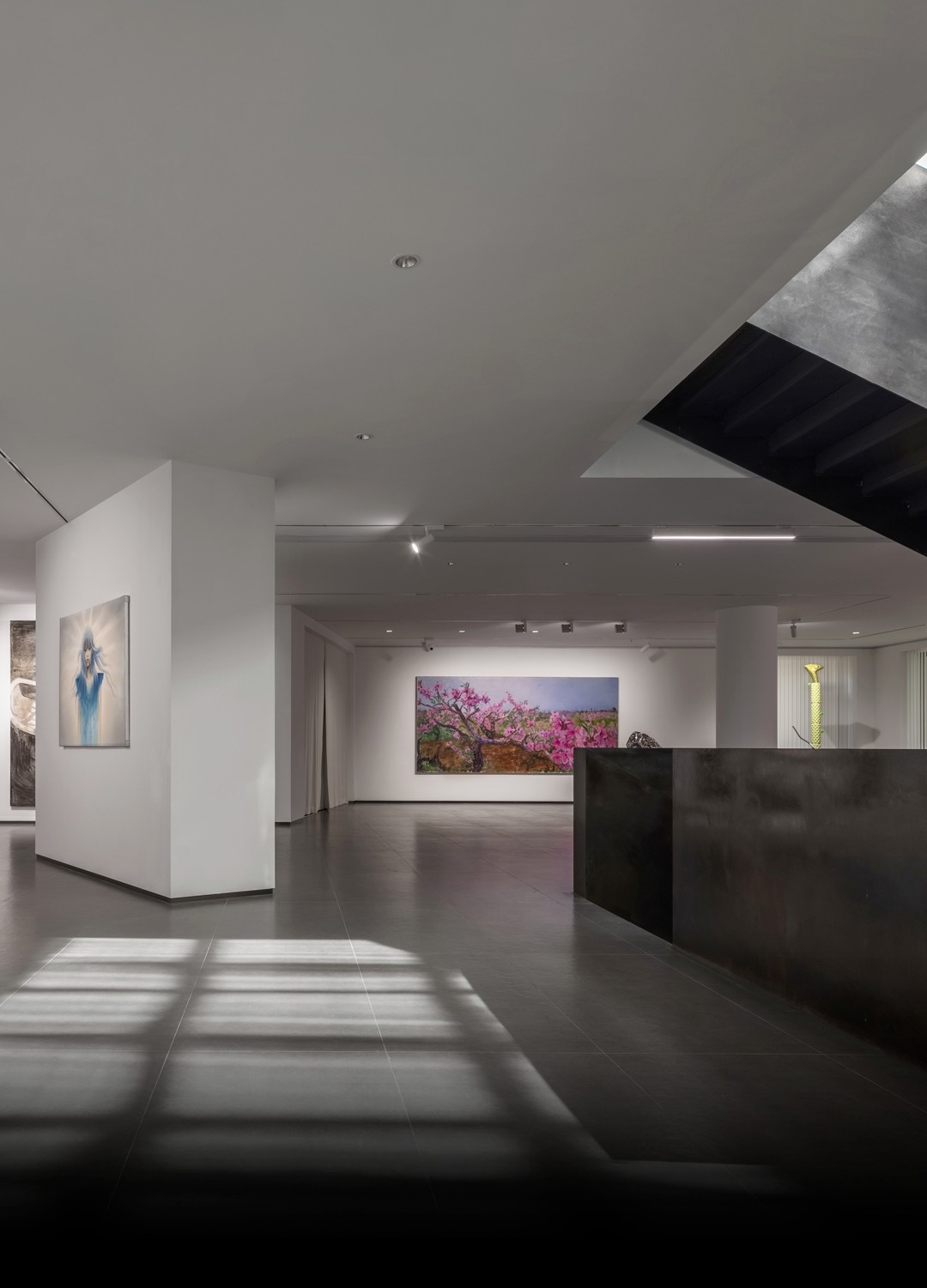梅松鹤×悠艺术中心 · 至简至美 首
2024-11-29 15:40


打破传统与当代的界限,呈现艺术的魅力,悠游于艺术与生活之中,探寻精神与物质的品格。
Break the boundaries between tradition and the contemporary era, present the charm of art, wander freely between art and life, and explore the qualities of the spiritual and the material.




悠艺术中心地处繁华喧闹的北京东三环CBD核心区域,毗邻团结湖公园。作品闹中取静,采用大量的留白来衬托馆陈艺术品。建筑本身注重自由立面和光影的变化,将室内空间与室外的湖光景色融合在一起。通过四季更替,让人们于室内就能感受到艺术品与自然的交流,艺术、建筑、自然在此交相辉映、相得益彰。
The Universal Art Centre is located in the core area of the bustling and noisy CBD on the East Third Ring Road in Beijing, adjacent to the Tuanjiehu Park. Its works create a peaceful atmosphere amidst the hustle and bustle, using a large amount of blank space to set off the artworks on display in the museum. The building itself focuses on the changes of free facades and light and shadow, integrating the indoor space with the outdoor lake views. Through the changing of the four seasons, people can feel the interaction between artworks and nature indoors. Here, art, architecture and nature complement each other and shine brightly together.




简约的建筑外观,洁白方正,犹如一块魔方镶嵌于此;融合宋代简约和时尚美学于一体。
The exterior of the building is simple, pure white and square, just like a Rubiks Cube inlaid here. It combines the simplicity of the Song Dynasty with modern aesthetics.




现代主义大师理查德·迈耶说:对我而言,白色就是所有色彩,白色创造了一种中性的表面,在这个表面上会出现空间感,并增强人对空间的结构感和秩序感。白色允许光和影的奢华表演,使建筑物沉浸在光线中,光线沉浸在每个角落。
The master of modernism, Richard Meier, said: For me, white is all colors. White creates a neutral surface on which a sense of space emerges and enhances peoples perception of the structure and order of space. White allows for a luxurious performance of light and shadow, immersing the building in light and allowing light to permeate every corner.


窗户化身镜头,捕捉春夏秋冬。正如宋代无门慧开禅师在《无门关·平常是道》中所言:“春有百花秋有月,夏有凉风冬有雪;若无闲事挂心头,便是人间好时节。”留白是为了激发观赏者的想象,而框定是为了引导观赏者的视线。中国的意境美在于景于意的“相兼”,此处,窗户换做“画框”,将团结湖的绿柳茵茵圈进室内,是现代主义建筑与自然主义融合的构思。
The windows serve as lenses, capturing the scenes of spring, summer, autumn and winter. Just as the Zen master Wumen Huikai in the Song Dynasty said in The Gateless Gate: Ordinary Mind Is the Way: There are hundreds of flowers in spring and a bright moon in autumn, cool breezes in summer and snow in winter. If there are no trifles weighing on your mind, it is a wonderful season in the world. The blank space is meant to stimulate the viewers imagination, while the framing is to guide their sight. The beauty of artistic conception in China lies in the combination of the scene and the meaning. Here, the windows are transformed into picture frames, enclosing the lush green willows around Tuanjiehu Lake into the interior, which is an idea that combines modernist architecture with naturalism.




当代艺术超越了对物质世界的直接描绘,通过形式和色彩,表达内在的精神和情感。作为一种能触动灵魂的媒介,艺术激发着观者的内心世界和情感共鸣。
Contemporary art goes beyond the direct depiction of the physical world. Through forms and colors, it expresses inner spirits and emotions. As a medium that can touch the soul, art stimulates the inner world of the viewers and evokes emotional resonance.




黑色斑驳的楼梯连接传统与现代,让岁月见证艺术的魅力。悠游此空间中,让人感受到建筑对艺术品强烈的衬托作用。在这里,精神和物质浑然一体。
The black mottled staircase connects tradition and modernity, allowing the passage of time to witness the charm of art. Wandering in this space makes people feel the strong contrasting effect that the building has on artworks. Here, the spiritual and the material are integrated seamlessly.




建筑本身通过各个方向的白色立面,使人站在馆内任何角落,都可以看到不同方向的画作。在这里,人可以体会到不同艺术家的精神的交流。展览中的作品通过不同的媒介和视角,展示了各个艺术家对于精神性的阐述。
The building itself, with its white facades in all directions, enables people to see paintings from different directions no matter which corner they are standing in inside the gallery. Here, people can experience the spiritual exchanges among different artists. The works in the exhibition, through different media and perspectives, demonstrate each artists interpretation of spirituality.


馆内中央动线的墙面,是展出本场次最震撼的作品的地方。在悠艺术中心呈现的作品《桃花》中,画家周春芽采用了分层处理画面肌理的方式,颜料流畅地延展于画布之上。画面中前景、中景与远景的桃花各具特色,笔触清晰有力,层次丰富,用色和谐明快。而建筑本身也是如此,结构有宏达,有精妙,有舒展,有紧凑。
The walls along the central circulation route inside the museum are the places where the most stunning works of this exhibition are displayed. In the work Peach Blossoms presented at the You Art Center, the painter Zhou Chunya adopted the method of layering to handle the texture of the picture. The paint spreads smoothly on the canvas. In the painting, the peach blossoms in the foreground, middle ground and background each have their own characteristics. The brushstrokes are clear and powerful, the layers are rich, and the colors are harmonious and lively. The same is true for the building itself. Its structure can be grand, exquisite, expansive or compact.


近处是盛开在观者眼前的桃红,远处则是蔓延至天际的芳菲。多层次的处理手法使得画面更具活力,观者驻足于画前便仿佛已置身于桃林,被这饱含生命力的盎然春意所吸引。艺术中多层次的处理手法同样适用于建筑。它会使建筑更具活力。观者驻足于馆内,仿佛置身于桃林,不仅近处的桃花绚烂,远处的嫩芽更让人心旷神怡。新鲜的空气中弥漫着泥土、青草和桃花的芬芳。
Nearby are the pink peach blossoms blooming right in front of the viewers, while in the distance are the beautiful scents spreading all the way to the horizon. The multi-layered treatment makes the picture more vibrant. When viewers stop in front of the painting, it seems as if they have already been in a peach grove, attracted by this vibrant spring full of vitality. The multi-layered treatment in art is also applicable to architecture. It will make the building more dynamic. When viewers stop inside the museum, it feels as if they are in a peach grove. Not only are the nearby peach blossoms gorgeous, but the tender buds in the distance are even more delightful. The fresh air is filled with the fragrances of earth, grass and peach blossoms.


我们希望通过空间,表现宋代风雅的意境美,可谓理性潜沉,气韵生动,也是一种追求极简美学的思想,这种极简在雨过天晴时,在无声留白中,在字里与行间,仿佛一叶扁舟,往青草更青处漫溯;又似一路孤行,往悬崖孤岭处登极。
We hope to present the elegant and artistic conception beauty of the Song Dynasty through space. It can be described as rational and profound, yet vivid in spirit. It is also an idea that pursues minimalist aesthetics. Such minimalism, when the rain stops and the sky clears, in the silent blank spaces, between the lines and within the words, is like a small boat, rowing slowly towards the greener areas of the grassland; and it also seems like walking alone all the way to the top of the cliff.


计白当黑的建筑立面,是中国书画的极静之美。瓷器的美在于温润的质感和接近自然的本质。中国的瓷器,在这个中式的窗景中,显得格外透亮,展现了瓷器本身的文化内涵。同时通过窗口对面的借景,给瓷器界定了新的背景,使其从过去穿越千年来到现代。空间中物质的东西少了,精神层面的东西就会多。
The building facades with the concept of treating the unpainted parts as painted ones embody the extreme tranquility beauty of Chinese calligraphy and painting. The beauty of porcelain lies in its warm and smooth texture and its essence close to nature. Chinese porcelain, set against this Chinese-style window view, appears particularly translucent, demonstrating the cultural connotations of porcelain itself. Meanwhile, through the borrowed scenery opposite the window, a new background is defined for the porcelain, enabling it to travel through thousands of years from the past to the present. When there are fewer material things in a space, there will be more on the spiritual level.


禅宗主张:“教外别传,不立文字;直指人心,见性成佛”。其意思就是要去除一切烦琐的仪式或程序,甚至连语言都可以抛弃,只保留最本真部分,这样方能摒弃杂念,顿悟出人生真谛!
禅宗的理念与极简风格去除装饰,保留核心功能的主张不谋而合。
Zen Buddhism advocates: A special transmission outside the scriptures, without reliance on words; directly pointing to the human mind, seeing ones nature and attaining Buddhahood. What it means is that all the cumbersome rituals or procedures should be removed, and even language can be abandoned. Only by retaining the most genuine part can one discard distracting thoughts and suddenly realize the true meaning of life!
The concept of Zen Buddhism coincides with the proposition of the minimalist style, which is to remove decorations and preserve the core functions.


我们在这个展陈空间中,把艺术品之外的装饰减少到最少,利用简单纵横交错的视觉效果,将空间连接,让画作一步一景的展现在观众眼中。
宋式美学的灵魂不仅是对美的极致追求,更传递着一种穿越时空的文化韵味和生活哲学。我们将现代主义建筑理论与宋式美学结合,表达了对自然、和谐和内省的崇尚。希望加强我们的文化自信和审美情趣,与“巨人”对话,共同探寻美的真谛。
In this exhibition display space, we have minimized the decorations other than the artworks. By utilizing the simple visual effect of crisscrossing vertical and horizontal lines, we have connected the space so that the paintings can be presented to the audience with a different scene at every step.
The soul of the Song-style aesthetics lies not only in the ultimate pursuit of beauty but also in conveying a cultural charm and life philosophy that traverses time and space. We have combined modernist architectural theories with Song-style aesthetics to express our admiration for nature, harmony and introspection. We hope to strengthen our cultural confidence and aesthetic taste, have a dialogue with the giants and jointly explore the true essence of beauty.
平面布置图 ©MHS DESIGN
立面图
剖面图
项目名称 |
悠艺术中心
Project Name |
Universal Art Centre
项目地点 |
中国 北京
Project Location |
Beijing, China
项目面积 |
1360㎡
Project Area |
1360㎡
项目类型 |
文化空间
Project Type |
Cultural space
完工时间 |
2023.3
Completion Time |
March 2023
主创设计 |
梅松鹤
Chief Designer |
Mei Songhe
设计团队 |
丁维明、汪明月、梅松柏、王筝、石林
俊、赵津
Design Team |
Ding Weiming, Wang Mingyue, Mei Songbai, Wang Zheng, Shi Linjun, Zhao Jin.
项目摄影 |
王华兵
Project Photographer |
Wang Huabing


梅松鹤,曾学习于北京师范大学、意大利佛罗伦萨大学,硕士学位;高级室内建筑师,中国建筑学会会员,香港室内设计师协会专业会员,中华美学学会会员,意大利“绘意杯”绘画大赛专家评委,中国宗教学会易道文化研究专业委员会常务理事;书法作品入选纪念孔子诞辰2550年全国书画大展、获北京迎奥运电视书法大赛一等奖;在“中国人生活方式挑战赛”活动中被评为“北京十大设计师”;设计作品荣获中国国际空间环境艺术设计大赛“筑巢奖”、中国国际建筑与室内设计节“金外滩奖”、中国室内设计年度评选“金堂奖”、陈设中国·晶麒麟奖“空间陈设美学奖”、德国设计委员会“雅生室内设计奖”、意大利IIDA国际设计大奖、法国双面神国际设计大奖、美国IDA国际设计大奖、英国伦敦设计奖;并荣获筑巢中国美好人居70年“美好人居创造者”荣誉称号;作品发表于《参考消息》 《中国书法》 《书法》杂志;著有《历代经典碑帖技法解析——唐欧阳询九成宫醴泉铭》、《住宅美学二十讲——穿越历史的人居之美》



下载

































